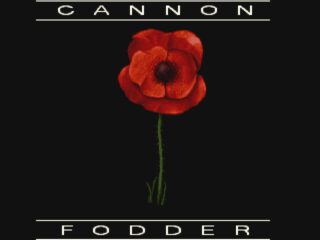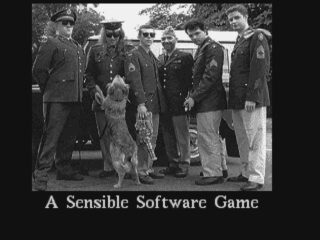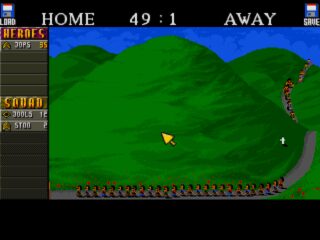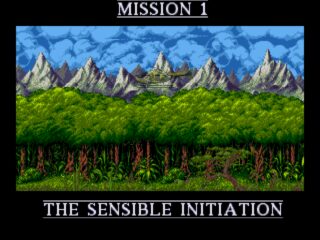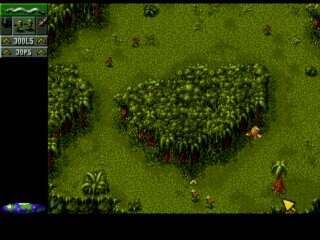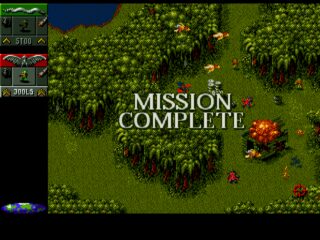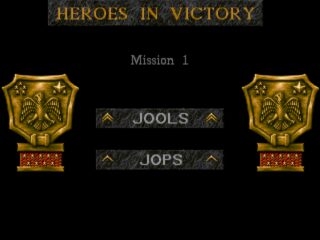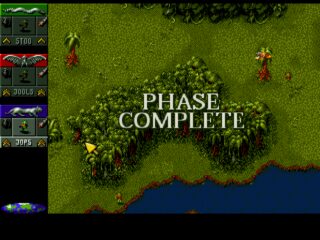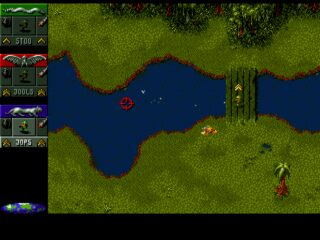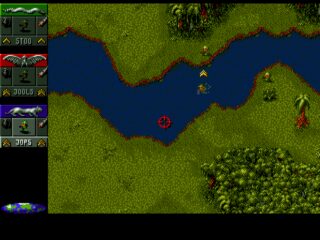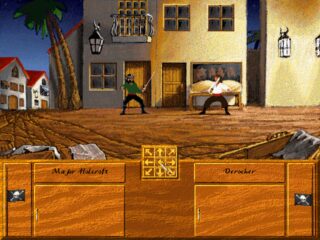Cannon Fodder is a top-down action strategy game originally developed by Sensible Software for the Amiga and released in 1993. Created by Jon Hare and Chris Yates, the game proved so successful that it was subsequently ported to numerous platforms including MS-DOS, Atari ST, Mega Drive, SNES, and many others.
The game employs Sensible Software's trademark bird's-eye view perspective, familiar to players of their football masterpiece Sensible Soccer. This viewpoint allows for precise tactical control while maintaining clear visibility of the battlefield, creating an ideal balance between strategic oversight and immediate action. Players command small squads of soldiers through various military missions, ranging from jungle warfare to desert operations, each presented with the distinctive visual style that made Sensible Software's games instantly recognizable.
What sets Cannon Fodder apart from other military action games like Commandos or Syndicate is its unique blend of serious tactical gameplay with irreverent British humor. The game's presentation is deliberately cartoonish, featuring tiny soldiers with exaggerated animations and death sequences that manage to be both comical and slightly unsettling. The famous "War has never been so much fun!" tagline perfectly encapsulates this contradiction, as the game simultaneously celebrates and satirizes military action.
The gameplay creativity shines through in the mission variety and tactical options available to players. Unlike more rigid strategy games such as Jagged Alliance or X-COM, Cannon Fodder allows for both careful planning and chaotic improvisation. Players can split their squads, use indirect fire support, and exploit environmental elements like explosive barrels or vehicles. The control scheme is intuitive, with simple mouse clicks directing movement and targeting, making complex tactical maneuvers accessible without overwhelming interface complexity.
The game's humor extends beyond visual gags to include memorable sound effects and music. The cheerful whistling theme tune creates an absurd contrast with the on-screen carnage, while the various weapon sounds and soldier voice samples add personality to the experience. This approach to audio design influenced later titles and remains one of the game's most distinctive elements.
Mission design demonstrates remarkable creativity, with objectives ranging from straightforward search-and-destroy operations to complex multi-stage scenarios involving hostage rescue, base infiltration, and vehicle-based combat. The game introduces new elements gradually, from basic rifle combat to rocket launchers, grenades, and even helicopter sequences. This progression keeps the experience fresh while building tactical complexity organically.
The squad management system adds emotional weight to the gameplay through its persistent soldier roster. Each trooper has a name and begins as a green recruit, potentially advancing through multiple missions to become a veteran. When soldiers die, they're genuinely lost, and their names appear on a memorial wall between missions. This mechanic creates genuine attachment to individual soldiers, making their loss meaningful in ways that similar games often fail to achieve.
Compared to contemporaries like Dune II or Populous, Cannon Fodder operates on a more intimate scale, focusing on individual soldiers rather than massive armies or abstract units. This approach creates more personal stakes and allows for the kind of emergent storytelling that made players remember specific battles or heroic last stands.
The game's influence on later titles is evident in games like Hotline Miami and Nuclear Throne, which share its combination of top-down action, dark humor, and intense tactical gameplay. The Sensible Software formula of accessible controls, creative mission design, and distinctive personality continues to resonate in modern game design.
Cannon Fodder succeeded in creating something genuinely unique in the early 1990s gaming landscape - a military action game that was simultaneously exciting, funny, and occasionally poignant. Its combination of tight tactical gameplay, creative mission design, and irreverent humor established it as one of the Amiga's most memorable exclusives before its multi-platform success spread its influence across the gaming world.

